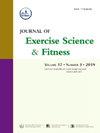比较有感觉统合障碍和无感觉统合障碍幼儿的大肌肉运动表现和体能
IF 2.4
2区 医学
Q2 SPORT SCIENCES
引用次数: 0
摘要
目的探讨感觉统合功能障碍(SID)儿童与典型感觉统合发育(TSID)儿童相比,是否在大运动表现和体能方面表现迟缓。此外,考虑到功能障碍严重程度(轻度与严重)和性别的差异,研究了SID儿童与大运动表现和身体健康相关的发育特征。方法随机招募患儿273例,其中SID患儿115例,其中轻度SID 85例,重度SID 30例。所有参与者使用“TGMD-2″”和“NPFMM”方案进行大肌肉运动技能和身体健康评估。采用协方差法分析SSID、MSID和TSID患儿大运动技能和体能的差异,以及SID患儿与TSID患儿的性别差异。结果(1)SID患儿的大运动能力显著低于TSID患儿(P <;0.05)。在跳跃、踢腿、击打、物体控制综合和总粗大运动得分等任务中观察到明显的缺陷。在男孩中,与TSID男孩相比,患有SID的男孩在大运动任务中的表现显著降低,包括跳跃、奔跑和滑动,以及较低的运动综合和总大运动得分。与TSID女孩相比,患有SID的女孩在跳跃、滑动、踢腿和投掷方面表现出明显的障碍,相应地,她们的物体控制综合得分较低。此外,患有SSID的女孩的滑动分数明显低于患有MSID的女孩。(2)在身体素质方面,SID儿童在敏捷性、速度和平衡方面的表现显著低于TSID儿童(P <;0.05)。具体来说,与TSID的男孩相比,SID的男孩表现出明显的敏捷性缺陷,而与TSID的女孩相比,SID的女孩表现出明显的速度缺陷。此外,患有MSID的儿童比患有SSID的儿童表现出更好的整体敏捷性,患有MSID的女孩比患有SSID的女孩表现出更好的速度表现。结论与TSID患儿相比,SID患儿大运动技能和体能的整体发展相对滞后。在患有SID的儿童中发现了性别特异性的发育差异。具体来说,患有SID的男孩在运动技能和敏捷性方面表现出明显的延迟,而患有SID的女孩主要表现出物体控制技能和速度方面的缺陷。此外,尽管SSID患儿在大运动技能和身体健康方面的表现比MSID患儿差,但不同程度功能障碍的差异总体上没有统计学意义。本文章由计算机程序翻译,如有差异,请以英文原文为准。
Comparing gross motor performance, physical fitness between young children with and without sensory integration dysfunction
Objectives
The aim of the present study was to investigate whether children with sensory integration dysfunction (SID) exhibit delays in gross motor performance and physical fitness compared to those with typical sensory integration development (TSID). Further, the developmental characteristics related to gross motor performance and physical fitness were examined in children with SID, taking into account differences in the severity of dysfunction (mild versus severe) and gender.
Methods
A total of 273 children were randomly recruited, including 115 children with SID, comprising 85 with mild SID (MSID) and 30 with severe SID (SSID). All participants underwent assessments of gross motor skills and physical fitness using the “TGMD-2″ and the “NPFMM” protocols. The covariance method was employed to analyze differences in gross motor skills and physical fitness among children with SSID, MSID, and TSID, as well as gender-based differences between children with SID and those with TSID.
Results
(1) Children with SID demonstrated significantly lower gross motor performance compared to their TSID peers (P < 0.05). Notable deficits were observed in tasks such as jumping, kicking, striking, and in the object control composite and total gross motor scores. Among boys, those with SID showed significantly reduced performance in gross motor tasks including jumping, galloping, and sliding, along with lower locomotor composite and total gross motor scores relative to TSID boys. Girls with SID exhibited significant impairments in leaping, sliding, kicking, and throwing, with correspondingly lower object control composite scores compared to TSID girls. Additionally, girls with SSID demonstrated a significantly lower sliding score than those with MSID. (2) With respect to physical fitness, children with SID performed significantly worse than TSID children in measures of agility, speed, and balance (P < 0.05). Specifically, boys with SID showed significant deficiencies in agility compared to boys with TSID, while girls with SID displayed notable shortcomings in speed compared to girls with TSID. In addition, children with MSID exhibited significantly better overall agility compared to those with SSID, and girls with MSID demonstrated superior performance in speed relative to their SSID counterparts.
Conclusions
The overall development of gross motor skills and physical fitness in children with SID was observed to be comparatively delayed relative to children with TSID. Gender-specific developmental differences were identified among children with SID. Specifically, boys with SID exhibited pronounced delays in locomotor skills and agility, whereas girls with SID primarily demonstrated deficiencies in object control skills and speed. Furthermore, although children with SSID showed poorer performance in gross motor skills and physical fitness compared to those with MSID, the differences across varying degrees of dysfunction were not statistically significant overall.
求助全文
通过发布文献求助,成功后即可免费获取论文全文。
去求助
来源期刊
CiteScore
5.10
自引率
3.60%
发文量
54
审稿时长
31 days
期刊介绍:
The Journal of Exercise Science and Fitness is the official peer-reviewed journal of The Society of Chinese Scholars on Exercise Physiology and Fitness (SCSEPF), the Physical Fitness Association of Hong Kong, China (HKPFA), and the Hong Kong Association of Sports Medicine and Sports Science (HKASMSS). It is published twice a year, in June and December, by Elsevier.
The Journal accepts original investigations, comprehensive reviews, case studies and short communications on current topics in exercise science, physical fitness and physical education.

 求助内容:
求助内容: 应助结果提醒方式:
应助结果提醒方式:


